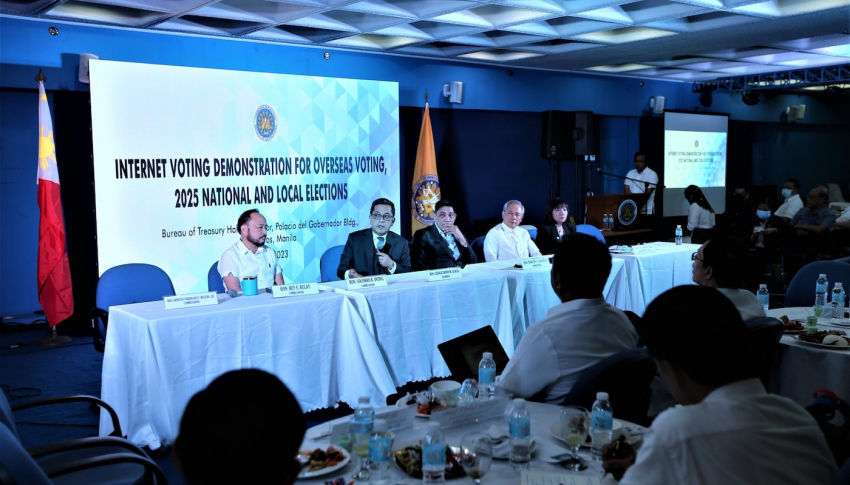
It cost at least P400 each for Filipinos overseas to vote in 2022. Is it time for online voting?
By Cherry Salazar
It has been two decades since the Philippines implemented overseas voting, allowing equal opportunity for eligible Filipinos outside the country to exercise their fundamental right of suffrage.
But, like most things, overseas voting comes with a price.
The Commission on Elections (Comelec) spent about P400 per registered overseas voter in the 2022 national elections, according to its chair George Erwin Garcia.
The Philippine Center for Investigative Journalism requested a breakdown of expenses for overseas voting, but the Comelec and the Department of Foreign Affairs (DFA) have not released the data as of this writing.
A total of 1,697,215 Filipinos registered for overseas automated and manual voting in the 2022 elections. Out of this total, only 688,961 actually voted or a turnout of 40.59 percent. It would translate to a total cost of about P678.88 million if Garcia’s declared cost per overseas Filipino voter was used as a basis.
688,961 Filipinos overseas absentee voters cast their votes during the 2022 elections. It’s only 40.59% of the nearly 1.7 million total registered voters.
But even P400 is a conservative amount. It accounts only for “direct costs,” according to Sonia Bea Wee-Lozada, director of the Comelec’s Office for Overseas Voting (OFOV).
“It does not yet include other expenses that were lumped with other items for the elections, such as ballot printing,” Wee-Lozada told the Philippine Center for Investigative Journalism (PCIJ) in an interview.
Overseas voting is done in two modes: mail-in voting, where embassies and consulates send ballots to the registered addresses of voters, who then send them back by post; and personal voting, where a voter personally casts his or her ballot in the embassy or consulate.
All ballots, equipment, and other election paraphernalia used in overseas voting are prepared by Comelec and shipped from the Philippines.
The forward and reverse logistics make up the bulk of the budget for overseas voting, said Wee-Lozada. Logistics alone amounts to about a fourth, or more than P100 million of the total allotment, she said.
This covers only the actual voting period and does not include costs related to voter registration and information dissemination campaigns.
Budget cut
Comelec was determined to implement internet voting for overseas voters in the 2025 elections, but budget cuts could derail its plans.
For 2024, it proposed P794.45 million for overseas voting, including the possible procurement of an internet voting system. But this was slashed to P23.36 million in the National Expenditure Program, which Malacañang submitted to Congress.
The elections body’s budget has suffered cuts over the years.
In 2022, its proposed budget for overseas voting was drastically reduced from P831 million to P111.91 million, and, consequently, its allocation for prepaid postage from P160 million to P6 million.
That was why some migrant Filipinos voting by mail complained about having to shoulder stamps and postage costs to send back their ballots to embassies and consulates, lawyer Rona Caritos recalled.
“The budget that was cut would really cover the actual means for overseas voting to run fully,’’ Caritos, executive director of the Legal Network for Truthful Elections (Lente), told PCIJ.
Comelec was forced to use part of their savings to cover the cost of postage.
“It’s a good thing they have savings. What about future elections?’’ Caritos said. “The government needs to allot a budget for this because we can’t depend on Comelec savings all the time.’’
High cost, low turnout?
Budget cuts have been blamed on the supposed cost inefficiency of overseas voting.
The 2022 elections recorded the highest turnout for overseas voting, with 40.59 percent of registered voters casting their ballot. But this rate — two out of five registered voters — is still lower compared with the domestic voter turnout of 84.10 percent.
While there is a “generally upward trend” in the total number of overseas Filipinos who registered and voted, there’s a “big gap’’ between these two, Foreign Undersecretary Jesus Domingo said.
Domingo chairs the DFA's Overseas Voting Secretariat (OVS), which works with Comelec's OFOV to mount overseas voting.
There is also a discrepancy between registered voters and the number of Filipinos working and living overseas, he added.
In 2022, there were 11 million Filipinos abroad. Of this, nearly 1.7 million registered to vote, and 688,961 voted.
Domingo, a former ambassador to New Zealand, cited two reasons for the low voter registration and turnout: indifference and inconvenience.
“These are among the things I hear and observe… One is, ‘What difference does my vote have, anyway?’ or ‘I’m not interested in politics,’” he told PCIJ. “The other is abala (inconvenience). They may be living far from the embassy or consulate.”
Some Filipinos also need to report for work. “When you spend a day without pay just to vote, that’s not an incentive for you,” Lente’s Caritos said.
Internet voting may yet address these issues.
Internet voting
As early as July 2021, the Comelec organized exploratory tests with internet voting service providers in preparation for the 2025 midterms.
Actual systems of three different providers were used by Filipino test voters abroad. They simulated the actual process from enrollment, log-in, and onboarding in the system, to the casting of ballots.
“The reception has been really positive because it’s easy. And at that time, almost everyone was stuck at home, so they saw the value of being able to do things from the safety of their homes,” Wee-Lozada said.
Comelec again held internet voting demonstrations with eight firms in July this year.
“The takeaway is, it has been successfully done in other countries. So if they can do it, why not us?” Domingo said, referring to Estonia, United Arab Emirates, and some parts of the United States.
Internet voting is not a silver bullet, Domingo said. “But it’s much easier to motivate somebody to do something if it’s easier.”
There have also been concerns about the integrity of internet voting. There have been questions about guarantees that the Filipinos who registered to vote overseas and not their representatives or alternates would be casting the votes on their behalf online.
The Comelec vowed to make sure that these guarantees are put in place.
Measures seeking to allow overseas internet voting should be a priority of Congress even if this would entail the amendment of the Overseas Voting Law of 2013, Lente said.
Pending new legislation, Comelec is now drafting its terms of reference for internet voting. But if it gets a measly budget, it will have a tough time preparing for the new system as early as next year.
“Elections are always costly. But costs should not be an issue because we’re talking here of the bedrock of democracy. Sure, the cost per head is high, but that’s the cost of democracy,’’ Caritos said. END




